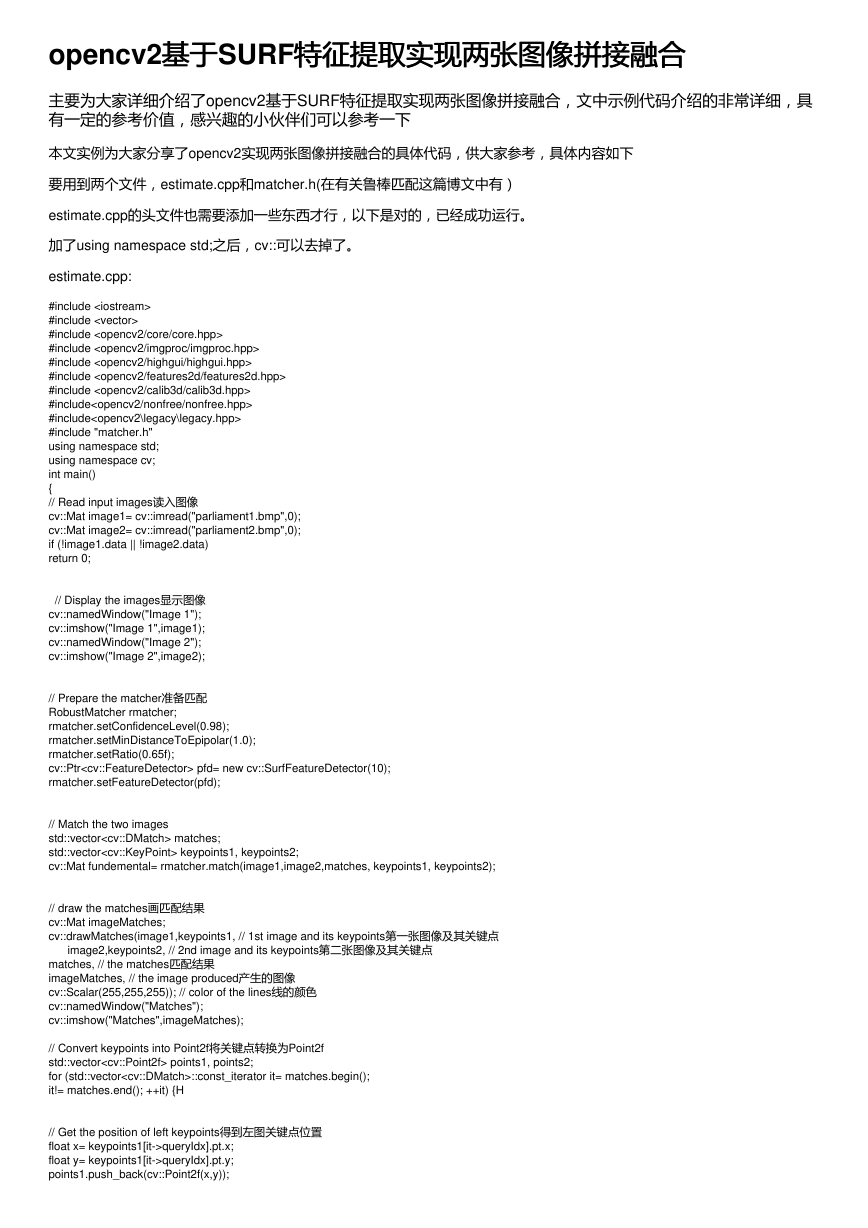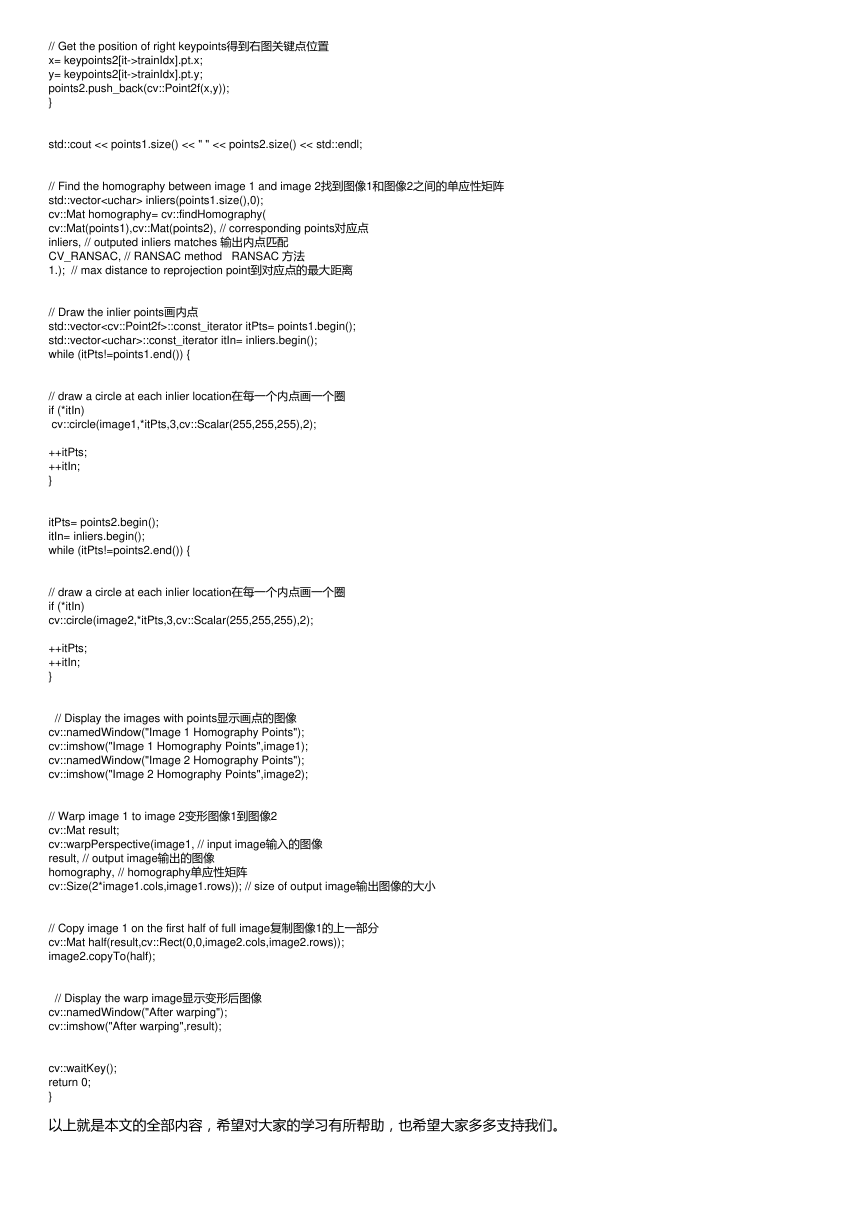opencv2基于基于SURF特征提取实现两张图像拼接融合
特征提取实现两张图像拼接融合
主要为大家详细介绍了opencv2基于SURF特征提取实现两张图像拼接融合,文中示例代码介绍的非常详细,具
有一定的参考价值,感兴趣的小伙伴们可以参考一下
本文实例为大家分享了opencv2实现两张图像拼接融合的具体代码,供大家参考,具体内容如下
要用到两个文件,estimate.cpp和matcher.h(在有关鲁棒匹配这篇博文中有)
estimate.cpp的头文件也需要添加一些东西才行,以下是对的,已经成功运行。
加了using namespace std;之后,cv::可以去掉了。
estimate.cpp:
#include
#include
#include
#include
#include
#include
#include
#include
#include
#include "matcher.h"
using namespace std;
using namespace cv;
int main()
{
// Read input images读入图像
cv::Mat image1= cv::imread("parliament1.bmp",0);
cv::Mat image2= cv::imread("parliament2.bmp",0);
if (!image1.data || !image2.data)
return 0;
// Display the images显示图像
cv::namedWindow("Image 1");
cv::imshow("Image 1",image1);
cv::namedWindow("Image 2");
cv::imshow("Image 2",image2);
// Prepare the matcher准备匹配
RobustMatcher rmatcher;
rmatcher.setConfidenceLevel(0.98);
rmatcher.setMinDistanceToEpipolar(1.0);
rmatcher.setRatio(0.65f);
cv::Ptr pfd= new cv::SurfFeatureDetector(10);
rmatcher.setFeatureDetector(pfd);
// Match the two images
std::vector matches;
std::vector keypoints1, keypoints2;
cv::Mat fundemental= rmatcher.match(image1,image2,matches, keypoints1, keypoints2);
// draw the matches画匹配结果
cv::Mat imageMatches;
cv::drawMatches(image1,keypoints1, // 1st image and its keypoints第一张图像及其关键点
image2,keypoints2, // 2nd image and its keypoints第二张图像及其关键点
matches, // the matches匹配结果
imageMatches, // the image produced产生的图像
cv::Scalar(255,255,255)); // color of the lines线的颜色
cv::namedWindow("Matches");
cv::imshow("Matches",imageMatches);
// Convert keypoints into Point2f将关键点转换为Point2f
std::vector points1, points2;
for (std::vector::const_iterator it= matches.begin();
it!= matches.end(); ++it) {H
// Get the position of left keypoints得到左图关键点位置
float x= keypoints1[it->queryIdx].pt.x;
float y= keypoints1[it->queryIdx].pt.y;
points1.push_back(cv::Point2f(x,y));
�
// Get the position of right keypoints得到右图关键点位置
x= keypoints2[it->trainIdx].pt.x;
y= keypoints2[it->trainIdx].pt.y;
points2.push_back(cv::Point2f(x,y));
}
std::cout << points1.size() << " " << points2.size() << std::endl;
// Find the homography between image 1 and image 2找到图像1和图像2之间的单应性矩阵
std::vector inliers(points1.size(),0);
cv::Mat homography= cv::findHomography(
cv::Mat(points1),cv::Mat(points2), // corresponding points对应点
inliers, // outputed inliers matches 输出内点匹配
CV_RANSAC, // RANSAC method RANSAC 方法
1.); // max distance to reprojection point到对应点的最大距离
// Draw the inlier points画内点
std::vector::const_iterator itPts= points1.begin();
std::vector::const_iterator itIn= inliers.begin();
while (itPts!=points1.end()) {
// draw a circle at each inlier location在每一个内点画一个圈
if (*itIn)
cv::circle(image1,*itPts,3,cv::Scalar(255,255,255),2);
++itPts;
++itIn;
}
itPts= points2.begin();
itIn= inliers.begin();
while (itPts!=points2.end()) {
// draw a circle at each inlier location在每一个内点画一个圈
if (*itIn)
cv::circle(image2,*itPts,3,cv::Scalar(255,255,255),2);
++itPts;
++itIn;
}
// Display the images with points显示画点的图像
cv::namedWindow("Image 1 Homography Points");
cv::imshow("Image 1 Homography Points",image1);
cv::namedWindow("Image 2 Homography Points");
cv::imshow("Image 2 Homography Points",image2);
// Warp image 1 to image 2变形图像1到图像2
cv::Mat result;
cv::warpPerspective(image1, // input image输入的图像
result, // output image输出的图像
homography, // homography单应性矩阵
cv::Size(2*image1.cols,image1.rows)); // size of output image输出图像的大小
// Copy image 1 on the first half of full image复制图像1的上一部分
cv::Mat half(result,cv::Rect(0,0,image2.cols,image2.rows));
image2.copyTo(half);
// Display the warp image显示变形后图像
cv::namedWindow("After warping");
cv::imshow("After warping",result);
cv::waitKey();
return 0;
}
以上就是本文的全部内容,希望对大家的学习有所帮助,也希望大家多多支持我们。
�




 2023年江西萍乡中考道德与法治真题及答案.doc
2023年江西萍乡中考道德与法治真题及答案.doc 2012年重庆南川中考生物真题及答案.doc
2012年重庆南川中考生物真题及答案.doc 2013年江西师范大学地理学综合及文艺理论基础考研真题.doc
2013年江西师范大学地理学综合及文艺理论基础考研真题.doc 2020年四川甘孜小升初语文真题及答案I卷.doc
2020年四川甘孜小升初语文真题及答案I卷.doc 2020年注册岩土工程师专业基础考试真题及答案.doc
2020年注册岩土工程师专业基础考试真题及答案.doc 2023-2024学年福建省厦门市九年级上学期数学月考试题及答案.doc
2023-2024学年福建省厦门市九年级上学期数学月考试题及答案.doc 2021-2022学年辽宁省沈阳市大东区九年级上学期语文期末试题及答案.doc
2021-2022学年辽宁省沈阳市大东区九年级上学期语文期末试题及答案.doc 2022-2023学年北京东城区初三第一学期物理期末试卷及答案.doc
2022-2023学年北京东城区初三第一学期物理期末试卷及答案.doc 2018上半年江西教师资格初中地理学科知识与教学能力真题及答案.doc
2018上半年江西教师资格初中地理学科知识与教学能力真题及答案.doc 2012年河北国家公务员申论考试真题及答案-省级.doc
2012年河北国家公务员申论考试真题及答案-省级.doc 2020-2021学年江苏省扬州市江都区邵樊片九年级上学期数学第一次质量检测试题及答案.doc
2020-2021学年江苏省扬州市江都区邵樊片九年级上学期数学第一次质量检测试题及答案.doc 2022下半年黑龙江教师资格证中学综合素质真题及答案.doc
2022下半年黑龙江教师资格证中学综合素质真题及答案.doc